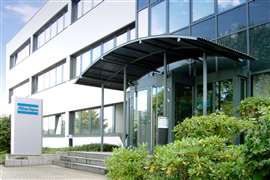Falsework & formwork special solutions
15 October 2013

Architects may be fond of coming up with extravagant and elaborate designs for everything from bridges to skyscrapers, but the challenge for contractors is to execute these complex schemes on time and on budget. It is an area where suppliers can not only help with technical advice and specialist design services, but also suggest ways to make the construction process more efficient.
When it comes to falsework and formwork, this often means providing solutions that allow complex and ever-changing shapes to be constructed using standard components that are easy to handle and modify on site.
Peri for example has seen its Variokit modular system being used for construction of a steel composite bridge over the extended Lanaye lock facility in Belgium, on the border with the Netherlands. Although based on standard rentable components, the formwork system has a complex function, acting as both a movable carriage and a cantilever bracket.
The locks link the Albert Canal with Juliana Canal, a side channel from the River Meuse. Construction of additional lock chambers will quadruple capacity, and as part of this project, a new 200 m long road bridge, with a 136 m main span, is being built across the shipping channel.
The S-shaped, 15 m wide bridge has cantilever lengths of 4.5 m, and these are being built using two Variokit composite formwork carriages, while radially-arranged Variokit cantilever brackets are being used for two 30 m long tightly curved approach structures.
The steel composite design involves first placing box-section steel beams, which support the slabs that are formed using the two Variokit carriages. The project involves casting the slab in 13 segments, from 8 m to 12 m long to a tight schedule, and the formwork carriages were delivered pre-assembled to reduce the time required on site.
They move on heavy-duty rollers which are mounted on supports on the steel structure with 4 m spacings. Their design features a longitudinal truss made out of standard main beams. The lateral units were designed to be adapted to the specified bridge section, and the system also helped with on-site safety. For example, the tie suspensions of the cantilever formwork were handled entirely from above.
On both banks of the river, the bridge alignment features two 90° bends – complete with extremely tight axis radii of almost 30 m respectively, and these were built using Variokit cantilever bracket units mounted on steel beams.
In addition, the complex geometric and static area where the circular columns are positioned were shuttered using standard forms for the most part.
The Bouregreg Bridge near Rabat, Morocco meanwhile is a 952 m long cable-stayed structure being built on two pylons measuring 197 m and 185 m high. The formwork solution to construct these towering structures was built around Doka’s SKE100 automatic climbing formwork system.
The bridge is the centrepiece of a new motorway bypass around Rabat. The formwork project is being handled by local subsuduary Doka Maroc SARL-AU for the MBEC-COVEC contractor joint venture. The formwork planning was carried out in collaboration with experts from Doka Headquarters in Amstetten, Austria.
The two pylons are oval in plan, with each comprising four curved pillars, and the bridge-deck will pass through the upward-tapering main piers half-way up. The inclination and cross-section of the pylons change with every pour, but the system supplied by Doka requires only minor modifications between each cycle. This is thanks to custom components and telescopic platforms that were supplied to complement the standard SKE100 system and Top 50 large-area formwork, as the basic elements of the formwork stay the same for each pour.
The bridge pylons are each being formed with 40 SKE100 automatic climbing formwork units and some 220 Top 50 units. There are 45 pouring cycles for the 185 m pylon and 48 for the 197 m tower, and one of the contractor’s key requirements was that quick progress could be achieved even in windy conditions.
Crane-lifted MF240 climbing formwork and Top 50 pieces are being used are being used on the five bridge piers and the pylons’ plinths.
Airport foundations
In June last year, the contract to build a new AED 10.8 billion (US$ 2.9 billion) terminal building at Abu Dhabi International Airport in the UAE was awarded to a consortium comprising TAV, CCC and Arabtec. The structure will include 65 gates and it is expected to open in 2017.
The early stages of construction includes the sinking of some 1,860 piles of diameters as large as 1 m to depths up to 25 m. On top of groups of piles sits a cast concrete head, which can be up to 22 m long, depending on how many foundations it links together – usually between two and 10 piles.
Paschal supplied its GE universal formwork for the construction of these pile heads, and one key feature is that it can be adjusted to the last centimetre, although 50 mm steps were adequate for the different foundation geometries. This meant the formwork for 16 different types of foundations could be cast from the same formwork units.
The modular formwork has a 15 mm thick, 11-layer plywood face made of Finnish beech. The frame comprises a steel frame which is easy to clean and repair, and the light weight of the individual elements means it is suitable for the manual placing – a key factor on this project as a crane was not always available.
Shoring challenge
A full range of RMD Kwikform formwork and falsework is being used to redevelop the Stade Vélodrome in Marseille, France. A futuristic new self-supporting roof is being constructed and the main Jean Buin Stand is being completely rebuilt, while the redevelopment of three others will boost capacity from 60,000 to 67,000 seats.
The revamp is in preparation for the Euro 2016 football tournament, and one reason for the modernisation and new roof is to address criticism from the 1998 World Cup that the stadium did not provide enough cover for spectators. But with some 6,000 new ‘business seats’ in the VIP section and increased capacity for general spectators, it was important that pillars supporting the new roof would not affect visibility.
To support the extremely heavy self-supporting roof structure during construction, a solution involving Megashor towers was devised by RMD Kwikform. Steel beams placed at various heights were connected to the stadium structure using special node points to further improve the towers’ structural integrity.
Specialist concrete bases were constructed around the stadium using piled cylindrical concrete with cast in-situ concrete beams to support the Megashor towers, allowing them to be simply dropped into place and firmly secured.
Each tower was assembled at ground level to reduce the risks of working at height, before being craned into place. Steel Superslim soldier bracing was used to tie the towers together to increase the load bearing capacity and wind resistance of the larger towers.
An RMD Kwikform spokesman said, “This was an incredibly complex design, but through the use of 3D modelling we were able to visualise a solution that we could put in place. One of the main challenges we encountered was dealing with the scale of the stadium while needing to cut production costs and speed up programme time. To overcome this, we designed a solution whereby we could reuse equipment from other parts of the stadium when it was no longer needed.
Affordable solution
At Barranquilla on Colombia’s Caribbean coast, the national housing ministry is building a new quarter called “Las Gardenias” with a total of 5,000 affordable apartments. Traditionally, residential construction in Colombia is carried out without a crane. Walls and slabs are poured in one go to save time and instead of plastering the walls, they are left as they are.
This meant the Unión Temporal Havivir contractor consortium required a formwork solution that was easy and quick to assemble by hand and robust enough for tough environmental and site conditions. It also needed a formwork face that could deliver a high-quality finish time after time and which could survive humid weather, and the system it went for was Meva’s AluFix hand-set formwork with Alkus all-plastic facing.
Although this is a relatively simple formwork solution, it was still a leap ahead in technology terms in Colombia, where projects on this scale normally use make-shift timber forms and props.
The walls of the apartments are 2.30 m high and 80 mm thick, while the slabs are 100 mm thick. AluFix covers the slab formwork with the same standard panels that are used for the walls, simply using props with special prop heads. This solution answered the contractor’s need for a simple system with a fast to set-up time.
With a capacity of up to 55 kN/m² concrete pressure, the formwork allows 2.30 m high walls to be completed in a single pour, along with the slab. One set of formwork is needed to complete all five levels of a building.
Thanks to the ambient temperatures of 25 to 35°C the concrete sets quickly, allowing the formwork to be struck soon after the pour. Another time advantage comes from the Alkus all-plastic facing, which was cleaned on site, and which is simple to repair if need be.
The project is due for completion next year and is progressing at a rate of 20 apartments per day, instead of the targeted 16 apartments per day. In addition to these a complete residential infrastructure is being developed on the site covering almost 5 ha, including community facilities, medical centres and schools, set in an extensive park.
This all goes to show that whether it is a complex bridge pylon or a simple apartment structure, formwork suppliers have a lot to offer from technical assistance to providing systems that can speed up work.







